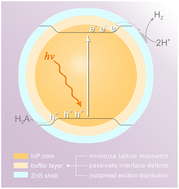Interface engineering of InP/ZnS core/shell quantum dots by the buffer monolayer for exceptional photocatalytic H2 evolution†
Abstract
InP-based quantum dots (QDs) are promising candidates for photocatalytic application owing to their eco-friendly properties. However, the numerous surface defects of InP QDs result in the extremely low utilization of photogenerated excitons in photocatalysis, therefore, it's vital for interface engineering to passivate the defect sites. Herein, we show that one Sx–In–P1−x buffer monolayer is well-integrated between the InP core and thin ZnS shell in a controlled manner by anion exchange. The in situ generated buffer layer could not only minimize the lattice mismatch to prevent the formation of misfit dislocation at the interface of the core and shell, but also the outspread distribution of electrons and holes could accelerate the charge separation. What's more, the use of low-reactivity S precursors for well-controlled anion exchange is beneficial for the preparation of a thin ZnS shell, which is convenient for the excitons tunnelling out of the surface of QDs. Therefore, the synthesized InP/InPS/ZnS core/buffer/shell QDs exhibit exceptional photocatalytic activity and stability at the rate of 102.04 μmol mg−1 h−1 and a TON of more than 310 000 per QD within 16 h irradiation; the rate is about 77 times higher than that of original InP QDs with an identical concentration.

- This article is part of the themed collections: #MyFirstJMCA and Photofunctional Materials and Transformations


 Please wait while we load your content...
Please wait while we load your content...